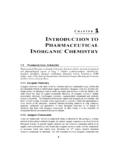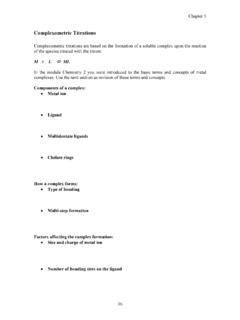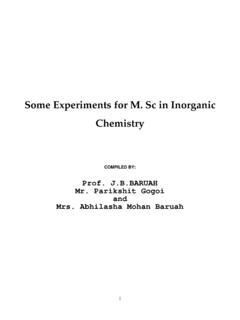Transcription of EXPERIMENT – 1 Estimation of Hardness of Water by EDTA …
1 Estimation of Hardness of Water by EDTA Method 1. EXPERIMENT 1 Estimation of Hardness of Water by EDTA Method INTRODUCTION. Water Hardness is the traditional measure of the capacity of Water to precipitate soap. Hard Water requiring a considerable amount of soap to produce leather. Scaling of hot Water pipes, boilers and other house hold appliances is due to hard Water . Hardness of Water is no specific constituent but is a variable and complex mixture of cations and anions. It is caused by dissolved polyvalent metallic ions. In fresh Water , the principle Hardness causing ions are calcium and magnesium. The other ions like Strontium, Iron, Barium and Manganese also contribute. Hardness is commonly expressed as CaCO3 in mg/L. The degree of Hardness of drinking Water has been classified in terms of the equivalent CaCO3 concentration as follows: Soft 0-60 mg/L.
2 Medium 60-120 mg/L;. Hard 120-180 mg/L;. Very hard > 180 mg/L;. Although Hardness is caused by cation, it may also be discussed in terms of carbonate (temporary). and non-carbonate (permanent) Hardness . Carbonate Hardness refers to the amount of carbonates and bicarbonates in solution that can be removed or precipitated by boiling. This type of Hardness is responsible for the deposition of scale in hot Water pipes and kettles. When total Hardness is numerically greater than that of total alkalinity expressed as CaCO3, the amount of Hardness equivalent to total alkalinity is called carbonate Hardness '. The amount of Hardness in excess of total alkalinity expressed as CaCO3 is non- carbonate Hardness . Non carbonate Hardness is caused by the association of the Hardness of causing cation with sulphate, chloride or nitrate and is referred to as permanent Hardness because it can not be removed by boiling.
3 AIM. To estimate the amount of total Hardness (Ca & Mg) present (as CaCO3) in the given Water sample by EDTA method. APPARATUS. 1. Conical flasks (100 mL) 2. Burette 3. Pipette 4. Spatula CHEMICALS. 1. Buffer solution 2. Inhibitor 3. Eriochrome black T indicator 4. Muroxide Indicator 5. NaOH (2N) 6. Standard EDTA Solution 7. Standard Calcium Solution THEORY. When Eriochrome Black T dye is added to the hard Water at pH around 10 it gives wine red coloured unstable complex with Ca+2 and Mg+2 ions of the sample Water . Now when this wine red-coloured 1. 2 Practical Engineering Chemistry complex is titrated agianst EDTA solution (of known strength) the colour of the complex changes wine red to original blue colour showing the endpoint. NaOOCH2 CH2 COOH. N CH2 CH2 N. HOOCCH2 CH2 COONa Disodium salt of ehtylenediamine tetraacetic acid: (Na2H2Y).
4 Where Y = deprotonated agent. In aqueous solution EDTA ionises to give 2Na+ ions and act as a strong chelating agent. Ca2+. Ca2+ . + Eriochrome black - T Eriochrome black - T Complex Mg2+ Mg2+ . (of Water ) (Unstable complex). (Wine-red). EDTA Ca2+ . 2+EDTA Complex + Eriochrome black - T. Mg (blue). The indicator used is a complex organic compound (sodium 1 (1-hydroxy 2-naphthylazo)-6- nitro-2-naphthol-4-sutphonate), commonly known as Eriochrome black T(EBT). It has two ionisable phenolic hydrogen atoms and for simplicity it is represented as Na+H2In : OH. OH. Na + SO3 N=N. NO2. Eriochrome Black-T. Eriochrome Black-T(EBT) is the metal ion indicator used in the determination of Hardness by complexometric titration with EDTA. This dye-stuff tends to polymerize in strongly acidic solutions to a red brown product, and hence the indicator is generally used in EDTA titration with solutions having pH.
5 Greater than The sulphuric acid gropus loses its proton much before the pH range of 7-12, which is of interest for metal ion indicator use. The dissociation of the two hydrogen atoms of the phenolic groups only should therefore be considered and hence the dye stuff may be represented by the formula Estimation of Hardness of Water by EDTA Method 3. H2D . This functions as acid-base indicator with two colour changes as follows: H2D HD2 D3 . pH pH (Red) (Blue) (Yellowish, Orange). In the pH range 8-10, the blue form of the indicator HD2 gives a wine red complex with Mg2+: Mg+2 + HD2 MgD + H+. (Blue) (Wine red). Now if EDTA (H2Y2 ) is added to such a solution Mg2+ preferentially complexes with EDTA (since the metal EDTA complex is more stable than the metal-indicator complex) and liberates the free indicator HD2 at the end point, thereby producing a sharp colour change from wine red to blue.
6 These reactions during the EDTA titration may be summarized as follows Mg+2 + HD2 MgD + H+. (Blue) (Wine red). H2Y2 + Ca2+ CaY2 + 2H+. H2Y2 + Mg2+ MgY2 + 2H+. H2Y2 + MgD MgY2 + HD2 + H+. (Winered) (Blue). The metal ion-indicators of common use in EDTA titrations include: Eriochrome Black-T (or Solochrome Black), Muroxide (ammonium salt of purpuric acid), Eriochrome Blue-Black B (or Solochrome Black-6B), Patton and Reeders indicator, Solochrome Dark Blue or Calcon, Zincon, Xylenon Orange .. etc. The optimum pH for the determination of Hardness of Water is + and is adjusted by NH4. OH NH4Cl buffer. Advantages of EDTA method This method is definitly preferable to the other methods, because of : (i) Greater accuracy, (ii) convenience and (iii) more rapid procedure. Units of Hardness The followng units are used for expressing results.
7 1. Parts per million (PPM) : It is the number of parts of calcium carbonate equivalent Hardness present in one million parts of Water . 2. Milligram per lite (mg/L): It is the number of milligrams of Calcium carbonate equivalent Hardness present in one litre of Water . 3. Degree Clarke (oCl): It is the number of parts of CaCO3 equivalent Hardness present in 70,000. parts of Water . 4. Degree French (oFr): It is the number of parts of CaCO3 equivalent Hardness present in 105. (1 Lac) parts of Water . 4 Practical Engineering Chemistry The above four units are correlated as given below 1 PPM = 1mg/L = Cl = Determination of Hardness The following of any given Water sample may be determined by the following methods. (i) 's method (ii) Soap titration method (iii) EDTA method EDTA Method PREPARATION OF REAGENTS. 1. Buffer solution: Dissolve g NH4Cl in 143 ml NH4OH.
8 Add g magnesium salt of EDTA. to obtain sharp change in colour of indicator and dilute to 250 ml. If magnesium salt of EDTA is not available, dissolve g disodium salt of EDTA (AR grade) and 780 mg or 644 mg in 50 ml distilled Water . Add this to above solution of NH4Cl in NH4OH and dilute to 250 ml. 2. Inhibitor: Dissolve gm hydroxyl amine hydrochloride in 100 ml 95% ethyl alcohol or isopropyl alcohol. 3. Eriochrome black T(EBT) indicator: Mix gm dye with 100 gm NaCl to prepare dry powder. 4. Muroxide Indicator: Prepare a ground mixture of 200 mg of murexide with 100 gm of solid NaCl. 5. NaOH (2N): Dissolve 80 gm NaOH and dilute to 1000 ml. 6. Standard EDTA Solution : Dissolve gm EDTA disodium salt and dilute to 1000 ml. Standardized against standard calcium solution, 1ml =1mg CaCO3. 7. Standard Calcium Solution: Weigh accurately 1gm CaCO3 and transfer to 250 ml conical flask.
9 Then add 1:1 HCl till CaCO3 dissolve completely. Add 200 ml and boil for 20 to 30 min. then cool and add methyl red indicator. Add NH4OH 3N drop wise till intermediate orange colour develops. Dilute to 1000 ml to obtain 1ml=1mg CaCO3. PROCEDURE. (a) Total Hardness (i) Take 25 or 50 ml or well mixed sample in a conical flask (ii) Then add 1 to 2 ml buffer solution followed by 1 ml inhibitor (iii) Add a pinch of Eriochrome black T and titrate with standard EDTA ( ) till wine red colour changes to blue, then note down the volume of EDTA required (A) . (iv) Run a reagent blank. Note the volume of EDTA (B). (v) Calculate volume of EDTA required by sample, C = A B (from volume of EDTA required in steps (iii & iv). (b) Calcium Hardness (i) Take 25 or 50 ml sample in a conical flask (ii) Add 1 ml NaOH to raise pH to and add a pinch of muroxide indicator.)
10 Estimation of Hardness of Water by EDTA Method 5. (iii) Titrate immediately with EDTA till pink colour changes to purple. Note the volume of EDTA. used (A1). (iv) Run a reagent blank. Note the ml of EDTA required (B1) and keep it aside to compare end points of sample titrations. (v) Calculate the volume of EDTA required by sample, C1 = A1 B1. OBSERVATIONS AND CALCULATIONS. Water Sample Vs EDTA. S. No Volume of Water Burette Reading Volume of EDTA. sample (ml) Initial (ml) Final (ml) added (ml). 1. 2. 3. 4. C D 1000. (i) Total Hardness as CaCO3, mg /l =. Volume of sample in ml Where C = Volume of EDTA required by sample (with EBT indicator). D = mg CaCO3 equivalent to 1 ml EDTA titrant (1 ml MEDTA mg CaCO3). Molarity of EDTA. or (D = 1 ). C1 D 1000. (ii) Calcium Hardness as CaCO3, mg /l =. Volume of sample in ml Where C1= volume of EDTA used by sample (with murexide indicator).










